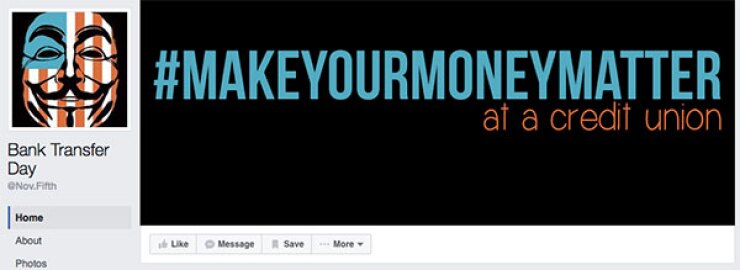
Bank Transfer Day – the consumer movement launched in 2011 that kicked off a growth spurt credit unions hadn't seen in decades – is set for a comeback following the Wells Fargo cross-selling scandal.
"None of it really surprises me," Bank Transfer Day founder Kristen Christian said of the Wells news. Christian launched Bank Transfer Day as a Facebook page in October 2011, initially hoping to inspire a few people to take their accounts away from for-profit banks and join credit unions. "I had to almost laugh to myself, because it was about this time five years ago that banks started doing stuff that was so outrageous that people responded by closing their accounts."
The movement began as a response to a plan by Bank of America – later aborted – to charge customers a $5 monthly fee for debit card use, and gained steam thanks to lingering resentment toward the big banks following the Great Recession and the Occupy Wall Street movement, which was at its height when Bank Transfer Day was launched. (Ironically, Wells Fargo introduced a $3 fee before B of A's $5 fee was announced, but Bank of America received the brunt of the criticism for its plan to charge consumers to access their own money).
Remaking a Global Phenomenon
The event became a global phenomenon, and Christian became an unlikely CU advocate, advocating for the movement on television, consulting for credit unions, working with leagues and trade organizations, and even speaking in the United Kingdom in 2012 as part of the United Nations' International Year of Cooperatives. Even the name itself was later trademarked and given to the Credit Union National Association in order to allow all credit unions to make use of the slogan "Make Every Day Bank Transfer Day."
Ultimately, credit unions
Details on the fifth-anniversary Bank Transfer Day event are still in the works, but it is expected to once again be focused on Nov. 5. And just like last time, Christian said it's more important that consumers switch to a credit union than whether or not they do so on that particular date.
Christian once said she didn't believe Bank Transfer Day
"We know it's not going to be anything like the first one was – we're not kidding ourselves," she said. "But at the same time, it's a great opportunity to get some people into credit unions and show them a viable alternative."
Skepticism Remains
There is some skepticism, however, about whether or not a large-scale push to convert bank customers to CU members can be successful in the wake of the Wells Fargo scandal.
Amy Herbig, CEO of The BA Group, a credit union marketing agency based in Northfield, Minn., cautioned that, as an industry, "we are not primed to capitalize on a situation such as this current Wells Fargo scandal."
She explained that credit unions still suffer from a lack of consumer awareness when it comes to the difference between a bank and a credit union. She also lamented that the public has a very short attention span, driven by a non-stop news cycle that quickly moves from one scandal to the next. What this means, she said, is that if credit unions wish to make a mark, they must do so quickly – but in cooperation with other credit unions in order to present an united front to maximize impact.
"Moments like these go way beyond an individual credit union, and we need to be a united industry under a global brand in order to help every individual credit union during times like these," she posited.
Who Do You Trust?
Gabe Krajicek, CEO of Kasasa, an Austin, Texas-based financial technology and marketing services company, noted that his firm's own research shows that consumers don't trust the big banks – and didn't trust them prior to the Great Recession, either. But, he said, it may not matter.
"In a way, this Wells Fargo news is just more of the same. Will it really change any consumer sentiment? Doubtful. Telling consumers things they already know – in this case, you can't trust banks like Wells Fargo – doesn't usually change their behavior or where they bank," he said.
Indeed, Krajicek pointed out that the mega-banks have relentlessly gained market domination in recent decades, regardless of the headlines. They had less than 30% market share in the mid-90s; today, it's above 70%.
"Clearly, despite disliking large banks, Americans still choose them when voting with their deposits," he said. "I would counsel credit unions not to look for a stumble from the competition for an advantage, but instead address the fundamental reasons that consumers overwhelmingly chose too-big-to-fail institutions instead of credit unions (or community banks for that matter)."
Kasasa's research reveals that two out of three consumers trust smaller institutions and think they have high ethics and great personal service. "But 71% of consumers say products are more important than the institutions themselves. Thus, people are voting for better products, and despite poor service, consumers believe the best products are at the largest banks."
A New Convert
With Wells Fargo in the news day-in and day-out for weeks, however, some consumers are already making the jump to credit unions.
Jessica Monsell, a consumer-advocacy blogger based in South Carolina, was a Wells Fargo customer for years, but has joined South Carolina FCU in the wake of the scandal. Monsell said she was not a victim of the unauthorized accounts set up by Wells Fargo employees, but her disgust – not just at the scandal, but at the banking giant's attempts to justify it – led her to look for other banking options, and she authored a widely read
"I simply don't trust them anymore to safeguard my money," she said of Wells Fargo. "Money represents time, and we work for our whole careers to save money. When we give it to someone to hold for us, we expect that they're protecting it and not trying to take advantage of us and the trust we've placed in the institution. For me it's a breach of trust and for that reason I had to leave the bank."
Monsell pointed out that her expertise lies in consumer advocacy and not in marketing, but said that the scandal creates an opportunity "for credit unions to really step up there and get their message out. I think there are a lot of people who, like me, are disgusted by what they've learned about their own bank."
However, she also recognized that inertia can be a difficult obstacle when it comes to changing financial institutions. But, she said, "if you can get the message out to consumers that these are the things we offer and these are the reasons we might be a better option or you, it's a great opportunity – and perfect timing."





